| BULGARIA |
| Population: 7,973,673 |
| Area: 110,993 sq. km |
| Language: Bulgarian |
| Predominant Religion: Bulgarian Orthodox |
| President: Georgi Parvanov |
| Ruling Party: National Movement Simeon II |
| Prime Minister: Simeon Saxe-Coburg-Gotha |
| Time zone: GMT +2; Apr-Sept GMT +3 |
| Summer temperatures: 26- … 30-C |
| Capital: Sofia |
| Winter temperatures: -5-... + 5-C |
| Sofia Population: 1,096,389 (14% of the country) |
Administrative and Territorial Division:
28 regions and 262 municipalities. | |
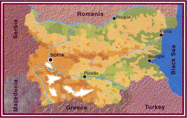 |
| Location and Territory |
| Bulgaria is located in South-Eastern Europe and occupies the North-Eastern part of the Balkan Peninsula To the North, the country borders on Romania via the Danube River, to the East it touches the Black Sea, its southern neighbors are Turkey and Greece, and to the West it borders on the Former Yugoslav Republic of Macedonia and Serbia.
The total territory of the country is 110,993 sq km and Bulgaria ranks 15th in size among the other European countries. |
| History |
 The Bulgarian state was founded in 681 AD as an union of Slavs, Thracians and Proto-Bulganans Tsar Boris I converted the state to Orthodox Christianity in 865.
This First Bulgarian State, which stretched from the Carpathians in the north to the Balkan range m the south, fell to the Byzantines in 1018.
The Second Bulgarian State, established in 1185 at Veliko Turnovo, reinstated the borders and a 'Golden Age' began in which Bulgaria bordered on three seas the Black, the Adriatic and the Aegean Seas.
From 1389 to 1878 the country was under the rule ('yoke' as the Bulgarians call it) of the Ottoman Turks.
Sofia became the capital of Bulgaria after the Veliko Turnovo Constitution was accepted in 1879. From 1878 (liberation from the Turks) to 1945, Bulgaria enjoyed a brief but unstable period of freedom In 1945 the Communist Party, led by Georgi Dimitrov, took power and proclaimed Bulgaria a 'People's Republic '. The oppressive Communist rule lasted till November 1989 when, following the lead of the other East European states, Bulgaria peacefully ousted the Party leader Todor Zhivkov and declared itself as a democratic republic. The Bulgarian state was founded in 681 AD as an union of Slavs, Thracians and Proto-Bulganans Tsar Boris I converted the state to Orthodox Christianity in 865.
This First Bulgarian State, which stretched from the Carpathians in the north to the Balkan range m the south, fell to the Byzantines in 1018.
The Second Bulgarian State, established in 1185 at Veliko Turnovo, reinstated the borders and a 'Golden Age' began in which Bulgaria bordered on three seas the Black, the Adriatic and the Aegean Seas.
From 1389 to 1878 the country was under the rule ('yoke' as the Bulgarians call it) of the Ottoman Turks.
Sofia became the capital of Bulgaria after the Veliko Turnovo Constitution was accepted in 1879. From 1878 (liberation from the Turks) to 1945, Bulgaria enjoyed a brief but unstable period of freedom In 1945 the Communist Party, led by Georgi Dimitrov, took power and proclaimed Bulgaria a 'People's Republic '. The oppressive Communist rule lasted till November 1989 when, following the lead of the other East European states, Bulgaria peacefully ousted the Party leader Todor Zhivkov and declared itself as a democratic republic. |
| Politics |
| Bulgaria is a parliamentary democratic republic with both a president and a Prime Minister Bulgaria has declared its intention to join both NATO and the EU Internal policy focuses mostly on the reform process and privatization. |
| Economy |
Stable, though the standard of living is still quite low. A currency board, in which the national currency is tied to the EURO, and all foreign investments are strictly monitored by the IMF, has been in effect since July 1997.
The exchange rate is fixed at BGL 1.95583 /EURO 1.
|
| Religion |
Eastern Orthodox Christians - 6 678 219 citizens, Islam - 966 087 citizens, Other religions - 17 030, Without any specific religious denomination - 312 337.
Full freedom of the religious denominations is proclaimed in the Constitution of the Republic of Bulgaria. |
| Population and Ethnic Groups |
7 973 673 citizens, incl. 6 660 682 Bulgarians, 757 781 Bulgarian Turks, 365 797 Gypsies and 189 413 significant numbers of Jews, Wallachs, Russians, Greeks.
Capital: Sofia (1 096 389 citizens).
Principal Cities: Plovdiv (340 638), Varna (314 539), Bourgas (193 316), Rousse (162 128). Stara Zagora (143 989), Pleven (122 149), Sliven (100 695), Dobrich (WO 379), Shoumen (89 054), Pernik (86 133), Yambol (82 924), Haskovo (80 870). |
| Official language |
| Bulgarian. Other spoken languages are English, German, French and Russian. |
| Relief |
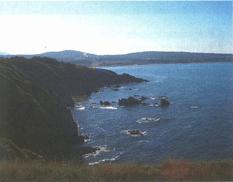 The country's relief is varied (from 0 to 2,925 m above the sea level) and about 60 percent of the territory are hilly and mountainous. The most famous mountains are: Rila (with the highest mountain peak on the Balkan Peninsula - Mussala- 2 925 m), Pirin (peak Vihren- 2 914 m), the Central Balkan (peak Botev- 2 376 m), the Rhodope Mountains (peak Golyam Perdik-2 191 m) and Vitosha Mountain near Sofia (peak Cherni Vrah- 2 191 m). Numerous natural phenomena are scattered across the country: mountain passes and gorges rock-pyramids and bizarre rock formations, numerous caves and waterfalls, beautiful lakes. Some of the most famous are: the Melnik Pyramids, the Fossil Forest, the Belogradchik Rocks; the gorges of the rivers Trigradska in the Rhodopes and Erma near the town of Tran, Vratsata; the valleys of the rivers Iskar, Struma and Mesta, the canyon of the Roussenski Lorn River; the Srebarna Lake; the rock monastery Aladja oft the city of Varna, etc. There is a great diversity of karst forms, among these some 4,300 caves. The deepest cave in Bulgaria is 415 m deep, and the longest- 15,535 m long. The best known are: the Ledenika, the Magurata and the Saeva Dupka Caves in the Balkan range; the Snezhanka, the Yagodinskata, the Dyavolsko Carlo, and the Uhlovitsa Caves- in the Rhodope Mountains. The country's relief is varied (from 0 to 2,925 m above the sea level) and about 60 percent of the territory are hilly and mountainous. The most famous mountains are: Rila (with the highest mountain peak on the Balkan Peninsula - Mussala- 2 925 m), Pirin (peak Vihren- 2 914 m), the Central Balkan (peak Botev- 2 376 m), the Rhodope Mountains (peak Golyam Perdik-2 191 m) and Vitosha Mountain near Sofia (peak Cherni Vrah- 2 191 m). Numerous natural phenomena are scattered across the country: mountain passes and gorges rock-pyramids and bizarre rock formations, numerous caves and waterfalls, beautiful lakes. Some of the most famous are: the Melnik Pyramids, the Fossil Forest, the Belogradchik Rocks; the gorges of the rivers Trigradska in the Rhodopes and Erma near the town of Tran, Vratsata; the valleys of the rivers Iskar, Struma and Mesta, the canyon of the Roussenski Lorn River; the Srebarna Lake; the rock monastery Aladja oft the city of Varna, etc. There is a great diversity of karst forms, among these some 4,300 caves. The deepest cave in Bulgaria is 415 m deep, and the longest- 15,535 m long. The best known are: the Ledenika, the Magurata and the Saeva Dupka Caves in the Balkan range; the Snezhanka, the Yagodinskata, the Dyavolsko Carlo, and the Uhlovitsa Caves- in the Rhodope Mountains. |
| Climate |
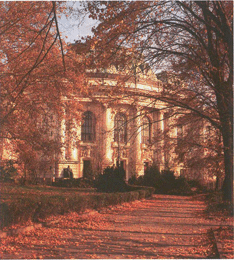 The climate is moderate continental with Mediterranean influence to the South. The average annual temperature is 10,5 degrees Celsius. Four seasons are distinctly expressed - winter, spring, summer and autumn. January is the coldest month of the year. July and August are due hottest summer months and sometimes temperatures go above 30 degrees Celsius. The climate is moderate continental with Mediterranean influence to the South. The average annual temperature is 10,5 degrees Celsius. Four seasons are distinctly expressed - winter, spring, summer and autumn. January is the coldest month of the year. July and August are due hottest summer months and sometimes temperatures go above 30 degrees Celsius. |
| Waters |
| There are about 500 mineral water deposits in Bulgaria with more than 1,600 springs. These are located mainly at the foothills of mountains. The spa resorts of national significance are Bankya, Velingrad, Sandanski, the mineral baths of Stara Zagora, Narechen, Sliven and Haskovo, as well as in Kyustendil, Varshets, Hissarya, Merichleri, Momin Prohod and Kostenets. Beautiful lakes lie hidden in the cirques of Rila and Pirin Mountains. |
| Flora and Fauna |
| Bulgaria is rich in places where nature has been preserved almost unspoiled and vegetation demonstrates remarkable diversity. A total of 12 360 species have been found in its composition. The Bulgarian endemic plants, which are to be found nowhere else m the world, number more than 250 species: Rila Primrose, Balkan Violet, Bulgarian Blackberry, Rhodope Tulip, etc. Forests abound with various wild fruit- all of them of proven flavour. There is also a great diversity of herbs. Bulgaria's fauna numbers more than 13,000 species. Rare mammal species are also to be found in the country. |
For more information about Bulgaria please visit the following sites:
http://www.bulgariatravel.org
|
| SOFIA |
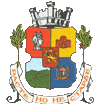 Sofia has a beautiful city centre whose many late 19th and early 20th century buildings have recently been restored with the help of the UNDP and EU's 'Beautiful Bulgaria' project. In some areas this neo-Classical and Secession architecture sits side by side with the monolithic constructions of the communist period. There are also many glossy new buildings, particularly office centres, and some have made a real effort to integrate their modern glass and metal components with the original facades of the buildings. The municipality has been busy over the past few years and has upgraded the old roads and revived some of the parks and gardens. Sofia has a beautiful city centre whose many late 19th and early 20th century buildings have recently been restored with the help of the UNDP and EU's 'Beautiful Bulgaria' project. In some areas this neo-Classical and Secession architecture sits side by side with the monolithic constructions of the communist period. There are also many glossy new buildings, particularly office centres, and some have made a real effort to integrate their modern glass and metal components with the original facades of the buildings. The municipality has been busy over the past few years and has upgraded the old roads and revived some of the parks and gardens.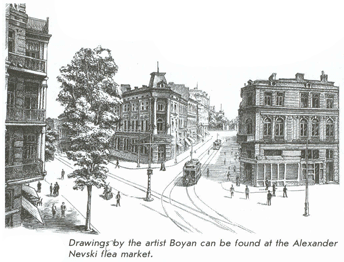 Although locals complain fiercely about the amount of traffic and air pollution, Sofia is actually quite a tranquil capital city. Car owners still form a relatively small portion of the population and the city is virtually empty on weekends. Outside of the centre most of the city's 1.1 million inhabitants live in the monstrous socialist housing complexes, but beyond these, the city is surrounded on all sides by wonderful mountain ranges. Over the last ten years the suburbs around Sofia, in particular those on Vitosha Mountain, have been overwhelmed with a non-stop building boom as the 'nouveau riche' battle to outdo each other with bigger and grander villas, many in total disregard of their beautiful setting and without the relevant planning permission. Anyone driving around these areas may be forgiven for thinking there is no economic hardship in Bulgaria.
Sofia became the capital of Bulgaria as recently as 1879, usurping the position from Veliko Turnovo after six hundred years. Sofia was felt to possess a strategic location and the change of capital marked the end of Bulgaria's dark ages under Ottoman rule. When it became capital, Sofia was a muddy, underdeveloped town of just 12,000 inhabitants, something akin to a large, open-air market. Historians talk of how the city's inhabitants attended the first royal ball dressed in woollen socks and baggy Turkish pants. The city's historic buildings date from the turn of the century up until the 1930s, when there was a rush to bring the city up to date and turn it into a modern European capital. Although locals complain fiercely about the amount of traffic and air pollution, Sofia is actually quite a tranquil capital city. Car owners still form a relatively small portion of the population and the city is virtually empty on weekends. Outside of the centre most of the city's 1.1 million inhabitants live in the monstrous socialist housing complexes, but beyond these, the city is surrounded on all sides by wonderful mountain ranges. Over the last ten years the suburbs around Sofia, in particular those on Vitosha Mountain, have been overwhelmed with a non-stop building boom as the 'nouveau riche' battle to outdo each other with bigger and grander villas, many in total disregard of their beautiful setting and without the relevant planning permission. Anyone driving around these areas may be forgiven for thinking there is no economic hardship in Bulgaria.
Sofia became the capital of Bulgaria as recently as 1879, usurping the position from Veliko Turnovo after six hundred years. Sofia was felt to possess a strategic location and the change of capital marked the end of Bulgaria's dark ages under Ottoman rule. When it became capital, Sofia was a muddy, underdeveloped town of just 12,000 inhabitants, something akin to a large, open-air market. Historians talk of how the city's inhabitants attended the first royal ball dressed in woollen socks and baggy Turkish pants. The city's historic buildings date from the turn of the century up until the 1930s, when there was a rush to bring the city up to date and turn it into a modern European capital.
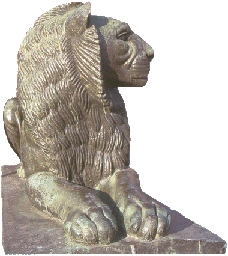 Evidence has been found that Sofia was inhabited as early as 7000 years ago. Thracian and Roman remains can still be seen dotted around the city: in the underpass in front of the presidency, behind the Military Club, and behind the Sheraton hotel. Sofia's thermal springs meant that it was always an attractive place for settlement. There are springs in the city centre, Gorna Banya, Bankya, Knyazhevo and Ovcha Kupel. Under Thracian, and later Roman, rule Sofia was known as Serdika; from the middle of the 6th century the Byzantines renamed it Triaditsa and from the 9th century onwards during the First Bulgarian Kingdom it took on the Slavonic name of Sredets.
The city finally became known as Sofia from the beginning of the 15th century taking on the name Sofia (Wisdom), from St. Sofia church.
Sofia's coat of arms was designed in 1900. The city's motto "Raste no ne stare' (grows but does not age) was added a year later. During World War II, Sofia was badly bombed by allied air raids in the early months of 1944. Over 3000 buildings were totally destroyed and another 9000 damaged.
Municipal elections in October last year saw the incumbent mayor, Stefan Sofiyanski, elected for a third term with a narrow lead ahead of the Bulgarian Socialist Party candidate. The successes of his previous mandates include creating several wide new boulevards taking traffic away from the city centre, completing two stages of the city's underground and giving an altogether cleaner and more modern look to the city. On the downside he has failed miserably to tackle the stray dogs issue, the abominable parking situation and to exercise any control over building regulations. Evidence has been found that Sofia was inhabited as early as 7000 years ago. Thracian and Roman remains can still be seen dotted around the city: in the underpass in front of the presidency, behind the Military Club, and behind the Sheraton hotel. Sofia's thermal springs meant that it was always an attractive place for settlement. There are springs in the city centre, Gorna Banya, Bankya, Knyazhevo and Ovcha Kupel. Under Thracian, and later Roman, rule Sofia was known as Serdika; from the middle of the 6th century the Byzantines renamed it Triaditsa and from the 9th century onwards during the First Bulgarian Kingdom it took on the Slavonic name of Sredets.
The city finally became known as Sofia from the beginning of the 15th century taking on the name Sofia (Wisdom), from St. Sofia church.
Sofia's coat of arms was designed in 1900. The city's motto "Raste no ne stare' (grows but does not age) was added a year later. During World War II, Sofia was badly bombed by allied air raids in the early months of 1944. Over 3000 buildings were totally destroyed and another 9000 damaged.
Municipal elections in October last year saw the incumbent mayor, Stefan Sofiyanski, elected for a third term with a narrow lead ahead of the Bulgarian Socialist Party candidate. The successes of his previous mandates include creating several wide new boulevards taking traffic away from the city centre, completing two stages of the city's underground and giving an altogether cleaner and more modern look to the city. On the downside he has failed miserably to tackle the stray dogs issue, the abominable parking situation and to exercise any control over building regulations.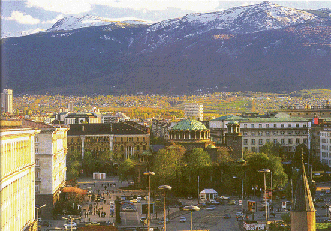 Soon after his re-election the tabloid press blew the cover on shocking deals with municipal property over the past 6 years and in particular the amount of land that had been sold off for less than the market price to shady groups implicated in organised crime. A smiling Sofiyanski pointed the finger at the previous municipal councils. Even so, he has kept an uncharacteristically low profile since the scandal broke.
Sofia's main hotels are centrally located and many of the main sights are within easy walking distance. We have put together some walking tour suggestions to take in a variety of Sofia's main sights and you can spend anything from a couple of hours to a whole day along the route depending on whether you choose to visit the museums, galleries and shops en route. Unfortunately still far too many sights lack adequate information in any foreign language, so you may wish to enlist the services of a local guide or purchase a more detailed guide book. Soon after his re-election the tabloid press blew the cover on shocking deals with municipal property over the past 6 years and in particular the amount of land that had been sold off for less than the market price to shady groups implicated in organised crime. A smiling Sofiyanski pointed the finger at the previous municipal councils. Even so, he has kept an uncharacteristically low profile since the scandal broke.
Sofia's main hotels are centrally located and many of the main sights are within easy walking distance. We have put together some walking tour suggestions to take in a variety of Sofia's main sights and you can spend anything from a couple of hours to a whole day along the route depending on whether you choose to visit the museums, galleries and shops en route. Unfortunately still far too many sights lack adequate information in any foreign language, so you may wish to enlist the services of a local guide or purchase a more detailed guide book. |
For more information about Sofia please visit the following sites:
http://www.sofiacityguide.com
| |
| Last Update: 09 Aug 2005 | |
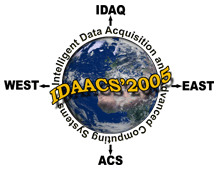




 The Bulgarian state was founded in 681 AD as an union of Slavs, Thracians and Proto-Bulganans Tsar Boris I converted the state to Orthodox Christianity in 865.
This First Bulgarian State, which stretched from the Carpathians in the north to the Balkan range m the south, fell to the Byzantines in 1018.
The Second Bulgarian State, established in 1185 at Veliko Turnovo, reinstated the borders and a 'Golden Age' began in which Bulgaria bordered on three seas the Black, the Adriatic and the Aegean Seas.
From 1389 to 1878 the country was under the rule ('yoke' as the Bulgarians call it) of the Ottoman Turks.
Sofia became the capital of Bulgaria after the Veliko Turnovo Constitution was accepted in 1879. From 1878 (liberation from the Turks) to 1945, Bulgaria enjoyed a brief but unstable period of freedom In 1945 the Communist Party, led by Georgi Dimitrov, took power and proclaimed Bulgaria a 'People's Republic '. The oppressive Communist rule lasted till November 1989 when, following the lead of the other East European states, Bulgaria peacefully ousted the Party leader Todor Zhivkov and declared itself as a democratic republic.
The Bulgarian state was founded in 681 AD as an union of Slavs, Thracians and Proto-Bulganans Tsar Boris I converted the state to Orthodox Christianity in 865.
This First Bulgarian State, which stretched from the Carpathians in the north to the Balkan range m the south, fell to the Byzantines in 1018.
The Second Bulgarian State, established in 1185 at Veliko Turnovo, reinstated the borders and a 'Golden Age' began in which Bulgaria bordered on three seas the Black, the Adriatic and the Aegean Seas.
From 1389 to 1878 the country was under the rule ('yoke' as the Bulgarians call it) of the Ottoman Turks.
Sofia became the capital of Bulgaria after the Veliko Turnovo Constitution was accepted in 1879. From 1878 (liberation from the Turks) to 1945, Bulgaria enjoyed a brief but unstable period of freedom In 1945 the Communist Party, led by Georgi Dimitrov, took power and proclaimed Bulgaria a 'People's Republic '. The oppressive Communist rule lasted till November 1989 when, following the lead of the other East European states, Bulgaria peacefully ousted the Party leader Todor Zhivkov and declared itself as a democratic republic. The country's relief is varied (from 0 to 2,925 m above the sea level) and about 60 percent of the territory are hilly and mountainous. The most famous mountains are: Rila (with the highest mountain peak on the Balkan Peninsula - Mussala- 2 925 m), Pirin (peak Vihren- 2 914 m), the Central Balkan (peak Botev- 2 376 m), the Rhodope Mountains (peak Golyam Perdik-2 191 m) and Vitosha Mountain near Sofia (peak Cherni Vrah- 2 191 m). Numerous natural phenomena are scattered across the country: mountain passes and gorges rock-pyramids and bizarre rock formations, numerous caves and waterfalls, beautiful lakes. Some of the most famous are: the Melnik Pyramids, the Fossil Forest, the Belogradchik Rocks; the gorges of the rivers Trigradska in the Rhodopes and Erma near the town of Tran, Vratsata; the valleys of the rivers Iskar, Struma and Mesta, the canyon of the Roussenski Lorn River; the Srebarna Lake; the rock monastery Aladja oft the city of Varna, etc. There is a great diversity of karst forms, among these some 4,300 caves. The deepest cave in Bulgaria is 415 m deep, and the longest- 15,535 m long. The best known are: the Ledenika, the Magurata and the Saeva Dupka Caves in the Balkan range; the Snezhanka, the Yagodinskata, the Dyavolsko Carlo, and the Uhlovitsa Caves- in the Rhodope Mountains.
The country's relief is varied (from 0 to 2,925 m above the sea level) and about 60 percent of the territory are hilly and mountainous. The most famous mountains are: Rila (with the highest mountain peak on the Balkan Peninsula - Mussala- 2 925 m), Pirin (peak Vihren- 2 914 m), the Central Balkan (peak Botev- 2 376 m), the Rhodope Mountains (peak Golyam Perdik-2 191 m) and Vitosha Mountain near Sofia (peak Cherni Vrah- 2 191 m). Numerous natural phenomena are scattered across the country: mountain passes and gorges rock-pyramids and bizarre rock formations, numerous caves and waterfalls, beautiful lakes. Some of the most famous are: the Melnik Pyramids, the Fossil Forest, the Belogradchik Rocks; the gorges of the rivers Trigradska in the Rhodopes and Erma near the town of Tran, Vratsata; the valleys of the rivers Iskar, Struma and Mesta, the canyon of the Roussenski Lorn River; the Srebarna Lake; the rock monastery Aladja oft the city of Varna, etc. There is a great diversity of karst forms, among these some 4,300 caves. The deepest cave in Bulgaria is 415 m deep, and the longest- 15,535 m long. The best known are: the Ledenika, the Magurata and the Saeva Dupka Caves in the Balkan range; the Snezhanka, the Yagodinskata, the Dyavolsko Carlo, and the Uhlovitsa Caves- in the Rhodope Mountains. The climate is moderate continental with Mediterranean influence to the South. The average annual temperature is 10,5 degrees Celsius. Four seasons are distinctly expressed - winter, spring, summer and autumn. January is the coldest month of the year. July and August are due hottest summer months and sometimes temperatures go above 30 degrees Celsius.
The climate is moderate continental with Mediterranean influence to the South. The average annual temperature is 10,5 degrees Celsius. Four seasons are distinctly expressed - winter, spring, summer and autumn. January is the coldest month of the year. July and August are due hottest summer months and sometimes temperatures go above 30 degrees Celsius. Sofia has a beautiful city centre whose many late 19th and early 20th century buildings have recently been restored with the help of the UNDP and EU's 'Beautiful Bulgaria' project. In some areas this neo-Classical and Secession architecture sits side by side with the monolithic constructions of the communist period. There are also many glossy new buildings, particularly office centres, and some have made a real effort to integrate their modern glass and metal components with the original facades of the buildings. The municipality has been busy over the past few years and has upgraded the old roads and revived some of the parks and gardens.
Sofia has a beautiful city centre whose many late 19th and early 20th century buildings have recently been restored with the help of the UNDP and EU's 'Beautiful Bulgaria' project. In some areas this neo-Classical and Secession architecture sits side by side with the monolithic constructions of the communist period. There are also many glossy new buildings, particularly office centres, and some have made a real effort to integrate their modern glass and metal components with the original facades of the buildings. The municipality has been busy over the past few years and has upgraded the old roads and revived some of the parks and gardens. Although locals complain fiercely about the amount of traffic and air pollution, Sofia is actually quite a tranquil capital city. Car owners still form a relatively small portion of the population and the city is virtually empty on weekends. Outside of the centre most of the city's 1.1 million inhabitants live in the monstrous socialist housing complexes, but beyond these, the city is surrounded on all sides by wonderful mountain ranges. Over the last ten years the suburbs around Sofia, in particular those on Vitosha Mountain, have been overwhelmed with a non-stop building boom as the 'nouveau riche' battle to outdo each other with bigger and grander villas, many in total disregard of their beautiful setting and without the relevant planning permission. Anyone driving around these areas may be forgiven for thinking there is no economic hardship in Bulgaria.
Sofia became the capital of Bulgaria as recently as 1879, usurping the position from Veliko Turnovo after six hundred years. Sofia was felt to possess a strategic location and the change of capital marked the end of Bulgaria's dark ages under Ottoman rule. When it became capital, Sofia was a muddy, underdeveloped town of just 12,000 inhabitants, something akin to a large, open-air market. Historians talk of how the city's inhabitants attended the first royal ball dressed in woollen socks and baggy Turkish pants. The city's historic buildings date from the turn of the century up until the 1930s, when there was a rush to bring the city up to date and turn it into a modern European capital.
Although locals complain fiercely about the amount of traffic and air pollution, Sofia is actually quite a tranquil capital city. Car owners still form a relatively small portion of the population and the city is virtually empty on weekends. Outside of the centre most of the city's 1.1 million inhabitants live in the monstrous socialist housing complexes, but beyond these, the city is surrounded on all sides by wonderful mountain ranges. Over the last ten years the suburbs around Sofia, in particular those on Vitosha Mountain, have been overwhelmed with a non-stop building boom as the 'nouveau riche' battle to outdo each other with bigger and grander villas, many in total disregard of their beautiful setting and without the relevant planning permission. Anyone driving around these areas may be forgiven for thinking there is no economic hardship in Bulgaria.
Sofia became the capital of Bulgaria as recently as 1879, usurping the position from Veliko Turnovo after six hundred years. Sofia was felt to possess a strategic location and the change of capital marked the end of Bulgaria's dark ages under Ottoman rule. When it became capital, Sofia was a muddy, underdeveloped town of just 12,000 inhabitants, something akin to a large, open-air market. Historians talk of how the city's inhabitants attended the first royal ball dressed in woollen socks and baggy Turkish pants. The city's historic buildings date from the turn of the century up until the 1930s, when there was a rush to bring the city up to date and turn it into a modern European capital.
 Evidence has been found that Sofia was inhabited as early as 7000 years ago. Thracian and Roman remains can still be seen dotted around the city: in the underpass in front of the presidency, behind the Military Club, and behind the Sheraton hotel. Sofia's thermal springs meant that it was always an attractive place for settlement. There are springs in the city centre, Gorna Banya, Bankya, Knyazhevo and Ovcha Kupel. Under Thracian, and later Roman, rule Sofia was known as Serdika; from the middle of the 6th century the Byzantines renamed it Triaditsa and from the 9th century onwards during the First Bulgarian Kingdom it took on the Slavonic name of Sredets.
The city finally became known as Sofia from the beginning of the 15th century taking on the name Sofia (Wisdom), from St. Sofia church.
Sofia's coat of arms was designed in 1900. The city's motto "Raste no ne stare' (grows but does not age) was added a year later. During World War II, Sofia was badly bombed by allied air raids in the early months of 1944. Over 3000 buildings were totally destroyed and another 9000 damaged.
Municipal elections in October last year saw the incumbent mayor, Stefan Sofiyanski, elected for a third term with a narrow lead ahead of the Bulgarian Socialist Party candidate. The successes of his previous mandates include creating several wide new boulevards taking traffic away from the city centre, completing two stages of the city's underground and giving an altogether cleaner and more modern look to the city. On the downside he has failed miserably to tackle the stray dogs issue, the abominable parking situation and to exercise any control over building regulations.
Evidence has been found that Sofia was inhabited as early as 7000 years ago. Thracian and Roman remains can still be seen dotted around the city: in the underpass in front of the presidency, behind the Military Club, and behind the Sheraton hotel. Sofia's thermal springs meant that it was always an attractive place for settlement. There are springs in the city centre, Gorna Banya, Bankya, Knyazhevo and Ovcha Kupel. Under Thracian, and later Roman, rule Sofia was known as Serdika; from the middle of the 6th century the Byzantines renamed it Triaditsa and from the 9th century onwards during the First Bulgarian Kingdom it took on the Slavonic name of Sredets.
The city finally became known as Sofia from the beginning of the 15th century taking on the name Sofia (Wisdom), from St. Sofia church.
Sofia's coat of arms was designed in 1900. The city's motto "Raste no ne stare' (grows but does not age) was added a year later. During World War II, Sofia was badly bombed by allied air raids in the early months of 1944. Over 3000 buildings were totally destroyed and another 9000 damaged.
Municipal elections in October last year saw the incumbent mayor, Stefan Sofiyanski, elected for a third term with a narrow lead ahead of the Bulgarian Socialist Party candidate. The successes of his previous mandates include creating several wide new boulevards taking traffic away from the city centre, completing two stages of the city's underground and giving an altogether cleaner and more modern look to the city. On the downside he has failed miserably to tackle the stray dogs issue, the abominable parking situation and to exercise any control over building regulations. Soon after his re-election the tabloid press blew the cover on shocking deals with municipal property over the past 6 years and in particular the amount of land that had been sold off for less than the market price to shady groups implicated in organised crime. A smiling Sofiyanski pointed the finger at the previous municipal councils. Even so, he has kept an uncharacteristically low profile since the scandal broke.
Sofia's main hotels are centrally located and many of the main sights are within easy walking distance. We have put together some walking tour suggestions to take in a variety of Sofia's main sights and you can spend anything from a couple of hours to a whole day along the route depending on whether you choose to visit the museums, galleries and shops en route. Unfortunately still far too many sights lack adequate information in any foreign language, so you may wish to enlist the services of a local guide or purchase a more detailed guide book.
Soon after his re-election the tabloid press blew the cover on shocking deals with municipal property over the past 6 years and in particular the amount of land that had been sold off for less than the market price to shady groups implicated in organised crime. A smiling Sofiyanski pointed the finger at the previous municipal councils. Even so, he has kept an uncharacteristically low profile since the scandal broke.
Sofia's main hotels are centrally located and many of the main sights are within easy walking distance. We have put together some walking tour suggestions to take in a variety of Sofia's main sights and you can spend anything from a couple of hours to a whole day along the route depending on whether you choose to visit the museums, galleries and shops en route. Unfortunately still far too many sights lack adequate information in any foreign language, so you may wish to enlist the services of a local guide or purchase a more detailed guide book.